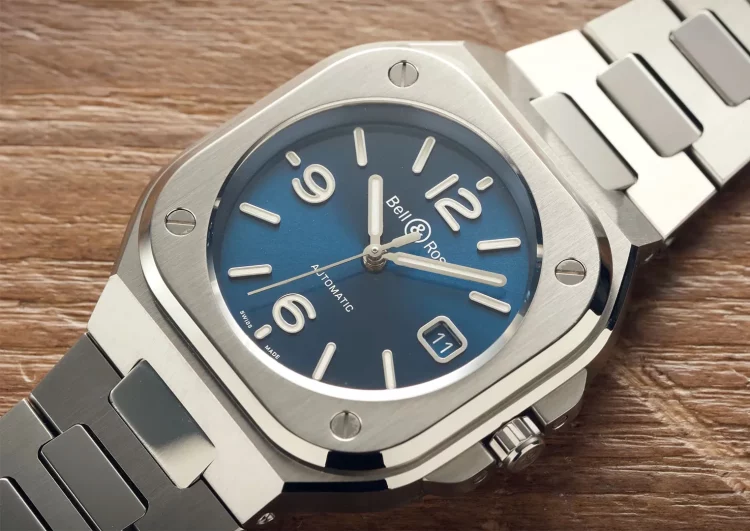Introduction
Bell & Ross, known for creating high-performance watches with a strong military and aviation influence, has carved a niche in the luxury watch world by blending functionality and elegance. From its iconic square-cased timepieces to its cutting-edge technology, Bell & Ross watches are built to withstand extreme conditions and provide precise timekeeping for professionals. However, as with any luxury watch, proper care and maintenance are essential to ensure that your Bell & Ross timepiece continues to perform at its best, preserving both its value and aesthetic appeal.
In this article, we will explore the care and maintenance required for Bell & Ross watches, offering expert tips on keeping your timepiece in prime condition. This will include essential steps such as cleaning, storage, water resistance checks, and battery replacement (for quartz models). Additionally, we will dive into how to properly handle your watch during various situations—whether you’re an aviation professional, diver, or collector. Whether you’re a proud owner of a BR 01, BR 03, or the sportier BR V2 series, understanding the best practices for maintenance will not only extend the life of your watch but also preserve its performance and aesthetic appeal.
1. Understanding Your Bell & Ross Watch: A Foundation for Proper Care
Before delving into the specifics of maintenance, it’s essential to understand what makes your Bell & Ross watch unique. Whether it’s a mechanical or quartz model, each timepiece is designed with durability and precision in mind. However, the materials used and the technology behind each model will influence how the watch should be maintained. Bell & Ross watches are known for their use of stainless steel, ceramic, titanium, and carbon composite materials, all of which have specific care requirements.
1.1 The Different Movements: Mechanical vs. Quartz
Bell & Ross produces both mechanical and quartz models, and understanding which type of movement you own is crucial for proper care. Here’s an overview:
- Mechanical Movements: These watches rely on the movement of the wearer’s wrist to power the watch, meaning they require regular use or periodic winding. Mechanical movements are sensitive to shocks, magnetic fields, and temperature changes.
- Quartz Movements: These are powered by a battery and require less maintenance compared to mechanical movements. However, battery replacements and occasional checks on water resistance are necessary for these models.
Knowing which type of movement your Bell & Ross watch has will inform how often you should service the timepiece, change the battery (for quartz models), or wind the watch (for mechanical models). Both types of watches, however, require proper care to ensure longevity and optimal performance.
2. Daily Care for Your Bell & Ross Watch
2.1 Cleaning Your Watch
Proper cleaning is essential for keeping your Bell & Ross watch looking as pristine as it did the day you bought it. Daily exposure to dirt, dust, sweat, and oils can cause buildup on the case, strap, and glass. Regular cleaning will help maintain the shine and functionality of your timepiece.
Cleaning Steps:
- Case: Use a soft microfiber cloth to wipe down the case and strap. Avoid using rough materials that could scratch the surface.
- Strap: For leather straps, wipe them down with a damp cloth and allow them to air dry. Avoid exposing leather straps to excess moisture. For metal bracelets, you can use a toothbrush with warm water and mild soap to remove dirt and grime from the links.
- Glass: The glass or sapphire crystal can be cleaned with a soft cloth or a lens cleaning cloth to remove fingerprints or smudges.
- Water-Resistant Models: If your Bell & Ross watch is water-resistant, you can gently rinse it with lukewarm water to remove salt or chlorine after swimming. Be sure to dry it thoroughly afterward.
2.2 Avoid Exposure to Harsh Chemicals
Bell & Ross watches, especially those with ceramic and titanium cases, are designed to resist corrosion, but exposure to chemicals such as perfume, detergents, and cleaning agents should be avoided. These chemicals can degrade the finish of your watch and, over time, weaken materials.
- Keep your watch away from cosmetics, cleaning products, and solvents.
- After exposure to saltwater or chlorine (from the ocean or a pool), make sure to rinse your watch under fresh water and dry it carefully with a soft cloth.
2.3 Protecting the Case and Glass from Scratches
While Bell & Ross watches use durable materials such as sapphire crystal for the glass, it is still susceptible to scratches, especially in extreme environments. To minimize the risk of scratches:
- Avoid rough activities: Whether you’re working or playing sports, avoid activities where the watch could come into direct contact with hard surfaces that could scratch it.
- Use protective pouches or cases if storing your watch in a bag or drawer.
- Be cautious when wearing your watch with jewelry or other metal objects that might cause abrasion.

3. Maintaining Water Resistance: Essential for Divers and Aviation Professionals
Water resistance is one of the key features of many Bell & Ross watches, particularly for diving and aviation professionals. It’s crucial to ensure that your watch maintains its water resistance over time.
3.1 Regular Water Resistance Checks
Bell & Ross watches are designed with varying levels of water resistance, typically ranging from 50 meters for casual use to 300 meters or more for professional divers. However, over time, gaskets and seals that ensure water resistance can degrade, especially if the watch is regularly exposed to water.
To maintain water resistance:
- Have the seals checked during regular servicing (every 3 to 5 years).
- Avoid pressing the crown or pushers when the watch is submerged in water.
- When not in use, ensure that the crown is properly screwed down or pushed in to prevent water from entering the case.
3.2 After Diving or Swimming
If you wear your Bell & Ross watch for diving or swimming:
- Rinse it off immediately after swimming in saltwater or chlorinated water to prevent corrosion.
- Dry it thoroughly with a soft cloth to avoid watermarks or rusting.
3.3 Checking for Leaks
If you notice moisture inside the crystal or fogging on the dial, it’s a sign that your watch has likely lost its water resistance. In this case, you should service your watch immediately to replace seals and gaskets.
4. Winding and Storing Your Bell & Ross Watch
4.1 Proper Winding of Mechanical Watches
For automatic mechanical models, such as those in the BR 01 or BR 03 collections, winding is essential to ensure the watch continues to run accurately. If you do not wear the watch regularly, it may lose power.
- Manual Winding: Wind your watch by turning the crown clockwise until you feel resistance. This ensures the watch has enough energy to keep ticking.
- Automatic Winding: Wear the watch regularly, and the movement of your wrist will wind the mainspring automatically.
4.2 Storing Your Watch
If you don’t plan on wearing your Bell & Ross watch for an extended period:
- Store it in a dry, cool place.
- Avoid storing it in areas with extreme temperature fluctuations, such as near heat sources or in direct sunlight.
- For automatic watches, consider investing in a watch winder if you have multiple timepieces, as this will keep the mechanical movement running smoothly.
5. Regular Servicing for Longevity and Performance
5.1 Why Regular Servicing Is Important
Bell & Ross watches are built to last, but regular servicing is essential to ensure that internal components, such as the movement, seals, and gaskets, continue to function as expected. Regular maintenance can help prevent problems like moisture leakage, dirt accumulation, or movement issues.
It’s recommended to have your Bell & Ross watch serviced every 3 to 5 years, depending on the model and usage. During a service, a certified watchmaker will clean, lubricate, and inspect the internal components, ensuring everything is functioning optimally.
5.2 What’s Included in a Service?
A typical service for a Bell & Ross watch includes:
- Cleaning of the movement and case.
- Lubrication of key parts to reduce wear and tear.
- Replacement of seals and gaskets to maintain water resistance.
- Checking the movement for accuracy and adjusting it as needed.
- Polishing the case and replacing any damaged parts.
6. Conclusion: Caring for Your Bell & Ross Watch
Caring for your Bell & Ross watch goes beyond just ensuring it looks good—it’s about maintaining its performance, longevity, and functionality. By following the guidelines outlined in this article, you can ensure that your timepiece remains in excellent condition for years to come.
Regular cleaning, storage, and servicing, along with being mindful of your watch’s specific needs, are all key components to preserving the luxury and performance that Bell & Ross is known for. Whether you’re wearing your watch on a daily basis or using it for more specialized purposes like diving or flying, proper maintenance will help your watch stand the test of time, keeping it running smoothly and looking as stunning as ever.
Key Takeaways:
- Regular cleaning and careful handling will maintain your watch’s appearance and function.
- Water resistance checks are crucial for watches exposed to water frequently.
- Servicing every 3 to 5 years will keep your timepiece in top working order.
- Protect your watch from extreme temperatures, chemicals, and physical shocks.
By following these tips and guidelines, you’ll keep your Bell & Ross watch in optimal condition, ensuring that it continues to perform and impress for years to come.





































